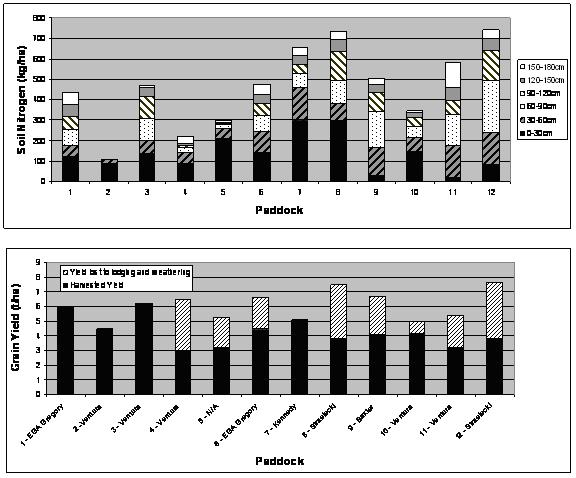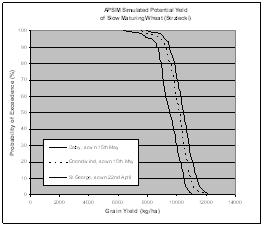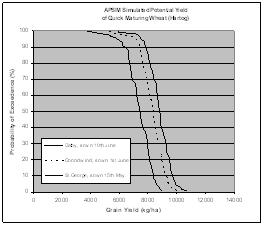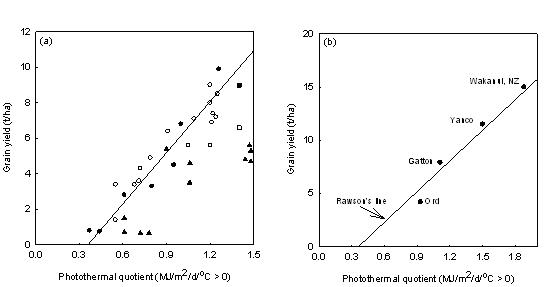Increasing Yield of Irrigated Wheat in Queensland and Northern NSW
Increasing Yield of Irrigated Wheat in Queensland and Northern NSW
| Date: 26 Nov 2009

GRDC code
CSA00015
Introduction
The decisions to grow irrigated wheat in 2008 in western parts of northern NSW, southern Queensland and central Queensland followed rain that arrived too late to sow cotton but which topped up farm storages and public dams. The high wheat price gave the prospect of earlier cash flow than the next cotton crop, and the earlier use of irrigation water also had the effect of reducing evaporation loss from shallow storages. Many growers and advisors had little experience in growing irrigated wheat, and their main sources of information were recommendations for northern dryland crops and irrigation areas in southern Australia (Angus and Lacy 2002), neither of which were highly relevant. The GRDC funded ‘Monitoring Irrigated Wheat’ project monitored 12 paddocks across Southern Queensland in 2008, and this paper reports some preliminary findings of this project, along with suggestions on how to manage irrigated wheat (and lodging risk) into the future. Additionally, we present preliminary results from the GRDC funded ‘Achievable Yields’ project on the yield potential of irrigated wheat across the region.
Post mortem of 2008 wheat
In many cases soils contained large amounts of mineral N at sowing (Figure 1a) because N fertiliser was applied in anticipation of a cotton crop several years earlier, but then the land remained fallow until 2008 because of insufficient irrigation water. Other paddocks in the region contained high levels of N due to over-fertilisation of recent crops. Wheat was sown across the region from early May following rain in late April. The early sowing, combined with high levels of soil mineral N, mild temperatures and above-average rainfall led to rapid vegetative growth in early winter. Lodging occurred at or after anthesis in many crops that received 2-3 irrigations, with some crops even lodging during early stem elongation, then ‘elbowing’ their way up to the vertical and lodging a second time. Lodged crops ripened later than standing crops and many were not harvested before the widespread rain in November, causing additional losses. The height of many crops before lodging was >120 cm, which is 20-30cm taller than high-yielding wheat in other parts of the world. Other problems were aphids and stripe rust, both of which were controlled with sprays. Most crops were free of root disease following long fallows.
Figure 1. Results of sampling 12 irrigated wheat paddocks across southern QLD in 2008 (a) mineral N in the top 1.8 m of soil at sowing (b) grain yield reported by farmers, and yield loss calculated from the difference between potential yield (estimated from APSIM or non-lodged quadrats) and quadrat cuts of lodged crops.
In the 12 monitored paddocks, soil mineral N averaged 460 kg/ha and harvested yield averaged 4.2 t/ha (Fig. 1). Only four of the crops did not lodge, and of these, only paddocks 1 and 3 yielded 6 t/ha. These crops were unique in that they were not grown on beds. One was grown on the flat and irrigated by lateral and the other was irrigated using shallow furrows on a heavy black vertosol. Both therefore avoided high within-row plant density. Both crops experienced water deficit during stem elongation which restricted biomass development before flowering.
Some crops lodged despite having relatively low potential yields. The reasons are not clear but may have been associated with excessively vigorous early growth. Analysis of data from these paddocks is continuing, and will be presented at future grower updates and project field days.
Lodging
In 2008 at least 20,000 ha of irrigated wheat lodged across southern Queensland and northern NSW causing a loss >$20 million in reduced grain yield and increased harvesting costs.
Lodging occurs when the stem is displaced from the vertical, and can be caused by bending of weak stems near the base (stem lodging) and/or overturning of the roots (root lodging). Both occur when the strength of the stem or soil is insufficient to hold the plant upright against the wind. Root lodging is more common in southern NSW, and occurs mostly in soils with low strength, particularly after irrigation or rain. Yield loss is greatest with early lodging and with the flattest crops.
Neither stem nor root lodging are easy to predict, but both are linked to tall, thick canopies which are more likely to develop due to high N levels, early sowing, long-season varieties and high seeding rates (Berry et al. 2000). Research in the UK (Sparkes & King, 2008) showed that the shading effect of a thick canopy weakens stems and surface roots, while the increased height and biomass of a high-input crop produces a longer lever that is more likely to bend the stem or displace the roots during high winds. We know that varieties vary in their inherent resistance to lodging but we do not yet have a complete picture of how often management, genotype and weather combine to cause lodging; just because it happened in 2008 does not mean it will happen again in 2009.
Strategies are needed to reduce lodging risk while maintaining a profitable yield level. In the short term, irrigated growers in the northern region may be best advised to target an attainable yield of 6 t/ha with later planting dates, quicker maturing varieties, and lower seeding rates than in 2008 in order to reduce lodging risk. Other short and long-term strategies are as follows.
Delayed N-application to minimise lodging
The principle behind delayed N application is to reduce vegetative growth with mild N stress, while maintaining an acceptable number of shoots. This strategy first requires a low N-status so that the mild stress can actually be imposed, however most paddocks sampled in 2008 had too much N present for this method to be of any use. We suggest that if growers wish to trial delayed N applications, mineral N from a ‘deep’ (to 100cm) soil nitrate test should be below 200 kg/ha. It is not essential to sample every paddock - representative paddocks can be sampled as a guide to others with a similar soil type, age and management history.
If soil mineral N is in the safe range, N fertiliser can be managed with a 2 or 3-step strategy modified from a method used in southern NSW. The first step of their system is to provide 120 kg/ha of mineral N in the top 40 cm at the time of sowing. This amount and depth was expected to produce about 800 shoots / m2 at DC30, which is on track for yield of 8 t/ha. Step 2 is to apply N at DC30 on crops with <800 shoots/m2 but not topdress those with ≥800 shoots / m2. At DC30 the rate of N application should be limited to ~50 kg/ha because of lodging risk. Step 3 is to topdress again between mid stem elongation (DC32) and anthesis (DC65), with the amount calculated by a supply–demand budget. The full 3-step strategy is required where the target yield is ≥8 t/ha but for a target of 6 t/ha there is less lodging risk so the second step can be by-passed and the third step can be brought forward to DC30-31. Alternatively, growers can monitor their crops with the Yield Prophet™ online monitoring service (www.yieldprophet.com.au) to balance their water and N requirements.
In southern NSW it is possible to obtain good yield responses with topdressing as late as anthesis, but N fertiliser generally has less effect on yield and more effect on grain protein with later application. Where possible, N should be applied before rain or irrigation. This condition applies particularly on alkaline soils where there is a high risk of N loss through volatilisation.
Topdressing on wet soils poses major logistical problems in all environments. Growers and machinery experts will have to work together to develop reliable application systems.
An alternative and more experimental system to delay crop uptake of N fertiliser is to inject ammonia or urea as mid-row bands at the time of sowing. Provided the concentration of ammonium in the band is high and soil temperature is low, nitrification and crop uptake can be delayed for several weeks. Slow release forms of fertiliser may also have a place in reduced lodging, but they are expensive.
These N management methods have not been tested in the northern region and will certainly need to be modified to apply to local conditions and varieties. It may take several cropping seasons to reduce N levels to a point where these methods can be used, given the extremely high levels of mineral N present in some paddocks in 2008. In the short term, double cropping wheat immediately after cotton may be the best way to achieve reduced levels of mineral N at sowing.
Other methods to minimise lodging
Another possible way to control lodging is with growth regulators. Several are widely used in Europe but the only product registered for wheat in Australia is CCC. MODUS® has been tested in southern Australia and is unlikely to be registered because it comes off patent in the next few years. Both CCC and Modus have been tested in irrigated and high-yielding dryland wheat in southern Australia but neither product has consistently prevented lodging or increased yield when used alone, and the results when used in combination are unconvincing. Other growth regulators are available in Europe but there are no steps to register them in Australia.
Research on how to obtain reliable responses from these products is justified in the region but the commercial use of CCC is risky.
Defoliating excessively leafy wheat crops also reduces lodging risk. In some regions vegetative crops are grazed with no yield loss, but this option is impractical on irrigation beds. Slashing is worth small-scale testing on irrigated wheat that is at risk of lodging. As a starting point slashing should be no shorter than 5cm and no later than DC31, when the flowering apex is 1-2 cm above the ground. Encouragement for defoliation comes from an agronomist at St George in 2008 who observed part of a paddock where wheat was grazed by ducks and stood up beautifully while the rest of the crop lodged!
As discussed earlier, mild water deficit during tillering and stem elongation may also reduce lodging risk. Paddocks number 1 and 3 (Figure 1b) experienced mild water deficit during stem elongation but still managed to yield 6 and 6.25 t/ha.
Genetic approaches to control lodging have good prospects in the long term but at considerable cost. Current semi-dwarf wheat varieties have the Rht1 gene which gives stature < 90 cm in dryland conditions and with low winter temperatures. At latitudes around 23-30ºS the short photoperiods and warm days allow stems to elongate during winter. Breeding for shorter straw may be possible within an Rht1 background and with other Rht loci. Improved lodging resistance may also be possible with improved stem stiffness. Wheat-breeding companies may be interested in developing shorter and stiffer straw varieties for northern irrigation areas if the industry becomes large enough – a classic chicken and egg situation. If the lodging problem is seen as a constraint to expansion of agriculture into northern Australia it could justify Climate Change funding. Meanwhile it is important to test all available agronomic methods.
Other limits to yield
Irrigated wheat in western regions between central NSW and central Queensland is limited by the same factors that affect wheat elsewhere in Australia such as risk of high temperature and frost, leaf diseases, nutrition and the problems of irrigating variable soil types. Root disease is likely to become a constraint to high yield if several wheat crops are grown in sequence but can be easily controlled with a break crop such as chickpea.
One unique feature of wheat the region is the sowing configuration on raised beds, where only 50-80% of the area is covered by crop. This pattern leads to incomplete radiation interception, but there is no Australian research on the effects on yield. Experiments with high-yielding (7 t/ha) irrigated wheat in a similar environment (latitude 27ºN) in Mexico suggest that gaps >44 cm between rows reduce yields by up to10%. The largest yield losses are generally from early maturing, short-stature varieties and the smallest losses are generally from late-maturing, taller varieties (Fischer et al. 2005).
Potential yields
The term “potential yield” here refers to crops that are not limited by water, lodging, frost, nutrients, soil toxicities, pests, disease or varietal adaptation. The assumed limitations are solar radiation and temperature and timing. We estimated potential yield using the APSIM crop model and the photothermal quotient (PTQ). Fig. 2 presents APSIM estimates at three locations with no limitations of water or nitrogen. At St George, the potential yield of a long-season variety in an average season was 9.5 t/ha and for a short-season variety was 7.5 t/ha.
|
(a)
|
(b)
|
 |
 |
Figure 2. Potential wheat yield simulated by APSIM for (a) long-season and (b) short-season variety.
Nix (1976) proposed PTQ as a simple index related to potential yield. PTQ is solar radiation divided by temperature for a particular stage of crop development (with units of MJ/m2/°C, >0 °C, megajoules of radiation per square metre per degree Celsius, above a base temperature of zero). Solar radiation drives yield through photosynthesis while temperature has an inverse effect on yield because growth duration decreases as temperature increases. Rawson (1988) showed that PTQ for the 30 days before anthesis explained wheat yield in temperate and tropical environments (Fig. 3a). The reason for selecting this period is that it straddles the stages when potential grain number is set, and it is known that yield is closed related to grain number per m2. The data in Fig. 3a represent potential yields using the technology available in the 1970s and 80s. Recent data from tropical, subtropical and temperate environments show that the relationship is still accurate (Fig. 3b). 
Figure 3. Relationship between wheat yield and photothermal quotient (a) from Rawson et al. (1988) with a line fitted to selected data set. (b) Yield data from experiments and farm crops with modern technology and varieties, along with the same fitted line.
We estimated potential yield for irrigated wheat-growing areas from central NSW to central Queensland (Table 1). The variation in estimated potential yield reflects the timing of anthesis as well as radiation and temperature. The effect of elevation on mean temperature is apparent from the data, with the higher potential yield in the cooler environments. The potential yields at St George are 5% less than the APSIM estimates for the average of a long-season variety.
Table 1. Estimated yield potential of wheat based on the photothermal quotient (PTQ) and a fitted relationship (YIELD = -3.45 + 9.59PTQ)
|
|
Elevation
(m)
|
Assumed anthesis date
|
Mean radiation*
(MJ/m2/d)
|
Mean temperature*
(ºC)
|
Yield potential (t/ha)
|
|
Trangie
|
217
|
23 Sept
|
17.8
|
14.1
|
9.6
|
|
Moree
|
211
|
14 Sept
|
16.7
|
13.6
|
9.4
|
|
Bourke
|
108
|
16 Sept
|
16.9
|
14.6
|
8.4
|
|
Dirranbandi
|
173
|
12 Sept
|
16.5
|
14.1
|
8.6
|
|
St George
|
201
|
12 Sept
|
16.4
|
13.6
|
9.1
|
|
Roma
|
340
|
2 Sept
|
17.0
|
12.3
|
11.7
|
|
Emerald
|
210
|
24 Aug
|
17.9
|
14.1
|
9.0
|
The GRDC funded ‘Achievable Yields’ project will look more closely at these preliminary estimates of yield potential as well as the currently attainable yield and how it can be raised to the potential.
Gross margins
When there is adequate water the gross margin per hectare for irrigated cotton is likely to be greater than for irrigated wheat at the attainable yield (Table 2). However cotton uses more irrigation water per hectare than wheat, so when water is limited, the area of cotton is less but returns per megalitre (ML) from cotton are still greater than from wheat. If water storages fill too late for cotton, as in 2007-08, options include sowing wheat or waiting for the next cotton crop. If the decision is to wait for cotton, there is additional evaporative loss of stored water, which may amount to at least 700 mm from a free-water surface in the 4 months between the peak irrigation periods for wheat (September) and cotton (January). This evaporation represents one-quarter of the volume of a 3-m deep storage. In Table 2, the gross margins per ML are expressed in relation to the irrigation water available at the time of sowing wheat. The gross margin per ML for wheat under these conditions is within 15% of the gross margin for cotton in 2009 conditions, and is greater than cotton at 2008 prices. The flexibility and rotational value of wheat justifies its place in cotton systems.
Table 2. Gross margins for wheat and cotton in 2009 with adequate supply of irrigation water, and for cotton after evaporative losses from water storages.
|
|
Irrigation*
|
Yield
|
Price
|
Variable
costs*
|
Gross margin /ha
|
Gross
margin / ML
|
|
Wheat
|
3.4 ML/ha
|
6 t/ha
|
$315 / t
|
$913 / ha
|
$977 / ha
|
$287 / ML
|
|
|
|
|
|
|
|
|
|
Cotton
|
6.0 ML/ha
|
Lint: 10 bales / ha
|
$400 / bale
|
$2300 / ha
|
$2660 / ha
|
$443 / ML
|
|
|
|
Seed: 3.2 t / ha
|
$300 / t
|
|
|
|
|
|
|
|
|
|
|
|
|
Cotton
|
“
|
“
|
“
|
“
|
“
|
$ 332/ML
|
|
(after evaporative losses)
|
|
|
|
|
||
Future Directions
The “Achievable Yields for Irrigated Grains” Project aims to establish improved agronomic practices, and publish achievable yield and water use benchmarks, for irrigated wheat and sorghum production specific to each irrigated valley in the northern region. Agronomic research will develop methods to reduce lodging risk without reducing yield, by optimising plant spacing, sowing date, bed layout and irrigation systems.
References
Angus J, Lacy J (2002). Nitrogen management for an 8 t/ha crop. IREC Farmers’ Newsletter, Large Area Edition, 161, 32-34.
Berry PM, Griffin JM, Sylvester-Bradley R, Scott RK, Spink JH, Baker CJ and Clare RW. (2000) Controlling plant form through husbandry to minimise lodging in wheat. Field Crops Research 67, pp. 59-81.
Fischer RA, Sayre, K, Ortiz Monasterio I. (2005). The effect of raised bed planting on irrigated wehat yield as influenced by variety and row spacing. pp. 1-11. In: Evaluation and performance of permanent raised bed cropping systems in Asia, Australia and Mexico. ACIAR Proceedings No 121. (ACIAR: Canberra)
Nix HA (1976) Climate and crop productivity in Australia. pp. 495-506. In: Climate and Rice. (International Rice Research Institute: Philippines)
Rawson, H.M. (1988). Effects of high temperatures on the development and yield of wheat and practices to reduce deleterious effects. pp. 44-61. In: A.R. Klatt (ed.). Wheat production constraints in tropical environments. (CIMMYT: Mexico)
Sparkes DL & King, M (2008).Disentangling the effects of PAR and R:FR on lodging-associated characters of wheat (Triticum aestivum). Annals of Applied Biology, 152, pp.1-9.
Contact details
Allan Peake, CSIRO Sustainable Ecosystems.
P.O. Box 102, Toowoomba, QLD, 4350
Ph: (07) 4688 1137
Fax: (07) 4688 1193
allan.peake@csiro.au
